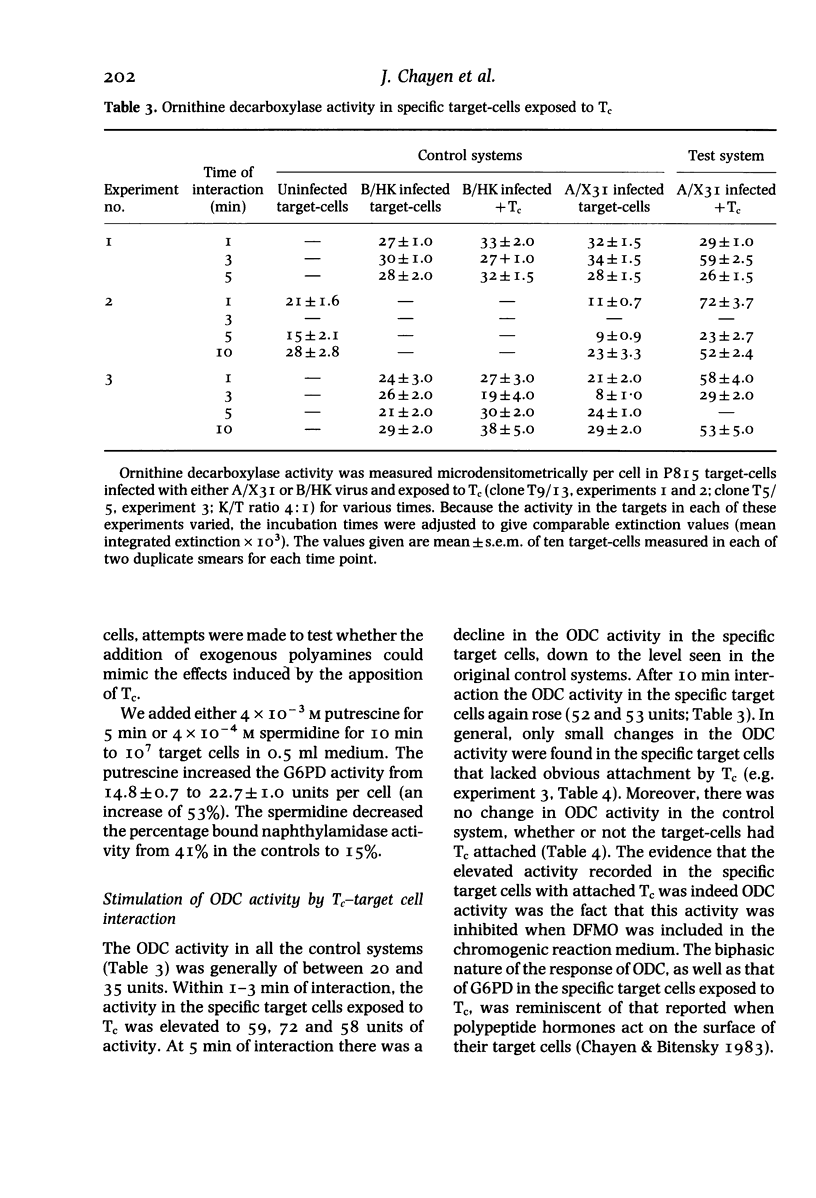Abstract
The mechanism by which cytotoxic T-lymphocytes (Tc) induce the death of specific target cells is still controversial. We have used quantitative cytochemical methods to distinguish the metabolic activities of the target cells from those of the Tc, even when they are attached to each other. Early events following Tc-P8(15) target cell interaction were first, increased glucose 6-phosphate dehydrogenase activity and second, labilization of the lysosomes within the target cell: these changes could be mimicked, in part, by polyamines and could be inhibited by inhibiting ornithine decarboxylase (ODC) activity. The crucial role of ODC in the chain of events that led to cytolysis in this particular experimental system was shown first, by measuring ODC activity directly and secondly, by the inhibition of cytolysis by the presence of a selective inhibitor of ODC activity.
Full text
PDF











Selected References
These references are in PubMed. This may not be the complete list of references from this article.
- Berke G., Rosen D. Are lytic granules and perforin 1 involved in lysis induced by in vivo-primed peritoneal exudate cytolytic T lymphocytes? Transplant Proc. 1987 Feb;19(1 Pt 1):412–416. [PubMed] [Google Scholar]
- Bitensky L., Alaghband-Zadeh J., Chayen J. Studies on thyroid stimulating hormone and the long-acting thyroid stimulating hormone. Clin Endocrinol (Oxf) 1974 Jul;3(3):363–374. doi: 10.1111/j.1365-2265.1974.tb01811.x. [DOI] [PubMed] [Google Scholar]
- Bodmer H. C., Pemberton R. M., Rothbard J. B., Askonas B. A. Enhanced recognition of a modified peptide antigen by cytotoxic T cells specific for influenza nucleoprotein. Cell. 1988 Jan 29;52(2):253–258. doi: 10.1016/0092-8674(88)90514-4. [DOI] [PubMed] [Google Scholar]
- Chayen J., Chayen R., Besser G. M., Bitensky L. Quantitative cytochemistry in the detection and analysis of sensitive rapid effects of hormones. Biochem Soc Trans. 1979 Oct;7(5):857–860. doi: 10.1042/bst0070857. [DOI] [PubMed] [Google Scholar]
- Golstein P. Cytolytic T-cell melodrama. Nature. 1987 May 7;327(6117):12–12. doi: 10.1038/327012a0. [DOI] [PubMed] [Google Scholar]
- Mamont P. S., Duchesne M. C., Grove J., Bey P. Anti-proliferative properties of DL-alpha-difluoromethyl ornithine in cultured cells. A consequence of the irreversible inhibition of ornithine decarboxylase. Biochem Biophys Res Commun. 1978 Mar 15;81(1):58–66. doi: 10.1016/0006-291x(78)91630-3. [DOI] [PubMed] [Google Scholar]
- Pasternack M. S., Eisen H. N. A novel serine esterase expressed by cytotoxic T lymphocytes. 1985 Apr 25-May 1Nature. 314(6013):743–745. doi: 10.1038/314743a0. [DOI] [PubMed] [Google Scholar]
- Pegg A. E., McGovern K. A., Wiest L. Decarboxylation of alpha-difluoromethylornithine by ornithine decarboxylase. Biochem J. 1987 Jan 1;241(1):305–307. doi: 10.1042/bj2410305. [DOI] [PMC free article] [PubMed] [Google Scholar]
- Pegg A. E. Recent advances in the biochemistry of polyamines in eukaryotes. Biochem J. 1986 Mar 1;234(2):249–262. doi: 10.1042/bj2340249. [DOI] [PMC free article] [PubMed] [Google Scholar]
- Pitsillides A. A., Taylor P. M., Bitensky L., Chayen J., Muir I. H., Askonas B. A. Rapid changes in target cell lysosomes induced by cytotoxic T cells: indication of target suicide? Eur J Immunol. 1988 Aug;18(8):1203–1208. doi: 10.1002/eji.1830180809. [DOI] [PubMed] [Google Scholar]
- Richman R., Park S., Akbar M., Yu S., Burke G. Regulation of thyroid ornithine ornithine decarboxylase (ODC) by thyrotropin. I. The rat. Endocrinology. 1975 Jun;96(6):1403–1412. doi: 10.1210/endo-96-6-1403. [DOI] [PubMed] [Google Scholar]
- Sanderson C. J. The mechanism of T cell mediated cytotoxicity. II. Morphological studies of cell death by time-lapse microcinematography. Proc R Soc Lond B Biol Sci. 1976 Jan 20;192(1107):241–255. doi: 10.1098/rspb.1976.0011. [DOI] [PubMed] [Google Scholar]
- Tabor C. W., Tabor H. Polyamines. Annu Rev Biochem. 1984;53:749–790. doi: 10.1146/annurev.bi.53.070184.003533. [DOI] [PubMed] [Google Scholar]
- Taylor P. M., Askonas B. A. Influenza nucleoprotein-specific cytotoxic T-cell clones are protective in vivo. Immunology. 1986 Jul;58(3):417–420. [PMC free article] [PubMed] [Google Scholar]
- Tschopp J., Masson D., Stanley K. K. Structural/functional similarity between proteins involved in complement- and cytotoxic T-lymphocyte-mediated cytolysis. 1986 Aug 28-Sep 3Nature. 322(6082):831–834. doi: 10.1038/322831a0. [DOI] [PubMed] [Google Scholar]
- Young J. D., Liu C. C. Multiple mechanisms of lymphocyte-mediated killing. Immunol Today. 1988 May;9(5):140–144. doi: 10.1016/0167-5699(88)91201-7. [DOI] [PubMed] [Google Scholar]
- Young J. D., Podack E. R., Cohn Z. A. Properties of a purified pore-forming protein (perforin 1) isolated from H-2-restricted cytotoxic T cell granules. J Exp Med. 1986 Jul 1;164(1):144–155. doi: 10.1084/jem.164.1.144. [DOI] [PMC free article] [PubMed] [Google Scholar]
- Zweerink H. J., Courtneidge S. A., Skehel J. J., Crumpton M. J., Askonas B. A. Cytotoxic T cells kill influenza virus infected cells but do not distinguish between serologically distinct type A viruses. Nature. 1977 May 26;267(5609):354–356. doi: 10.1038/267354a0. [DOI] [PubMed] [Google Scholar]


